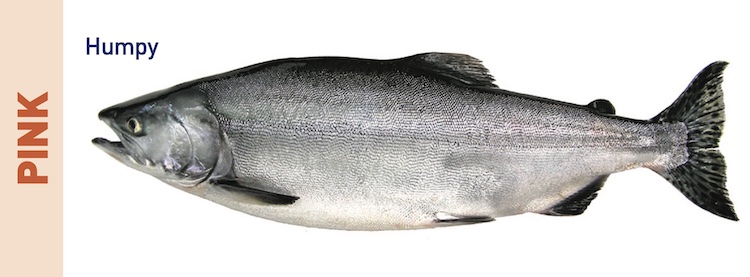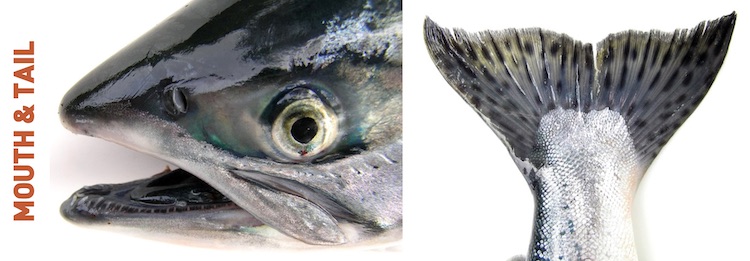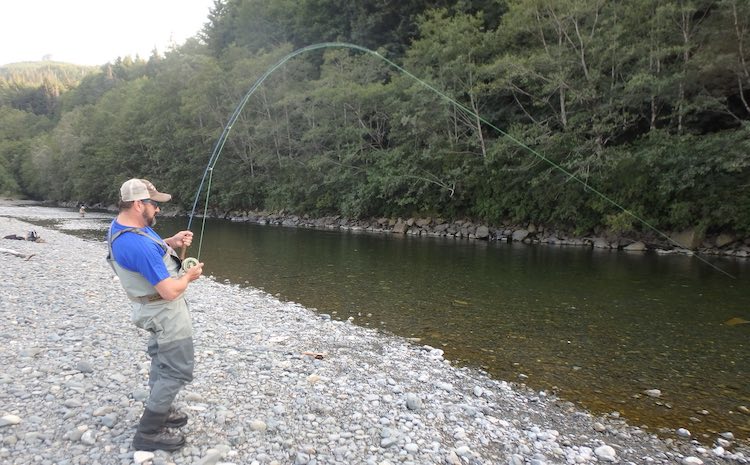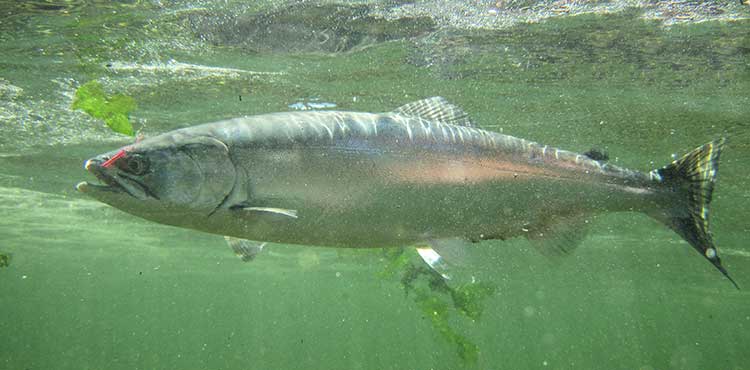
The heat of late July and August is not what most fly fishers consider prime fishing time. But those of us on the coast know that this time of year brings some wonderful fishing; the pink salmon run to the estuaries of their home rivers in preparation for spawning, and many fly fishers head out to take their turns at catching these lovely little salmon while getting a suntan at the same time.
Pink salmon, or “humpies,” run in two-year cycles. Every second summer they return to the streams and rivers that bore them to make their contribution to the survival of their species. On the mainland coast of British Columbia, pinks return every odd year, while on eastern Vancouver Island they spawn in the even years. And some rivers like the Oyster River near Campbell River are unique; their hatchery program has been so successful that as a result there is a run every year due to annual stocking of pink fry.

Gordon MacDonald with a nice pink salmon
As salmon go, pinks are the smallest, seldom exceeding six pounds when fully mature. They are nicknamed “humpies” because of the characteristic hump the males develop during the spawn, but they are more formally known as Oncorhynchus gorbuscha. Identification of these fish is quite easy. They are small and have large, oblong, blotchy spots on their tails rather than the small round dots found on coho and Chinook. They also exhibit white mouths and gums, whereas the Chinook have black mouths and gums and the coho have black mouths with white gums at the base of the teeth.


Pink salmon mouth and tail
- Mouth is white with black gum
- No ‘teeth’ on tongue
- Very small scales
- Large oval spots on both lobes of tail
- No silver on V-shaped tail
There is a definite technique to fly fishing for pinks from the ocean beaches or from shore in the estuaries. The slow retrieves required, combined with the soft takes of these fish, sometimes make their strikes almost undetectable, especially when the tides and currents are very slow or nonexistent. Their strike can often feel a lot like hooking into floating weed. With this in mind, it is good practice to always set your hook at the first sign of resistance; you’ll end up setting your hook into lots of weeds, but you will also hook more salmon.
Pinks are very soft-mouthed and care must be taken not to pressure them too much once hooked. If you are over aggressive when playing them, you’ll pull the hook out. Since they tend not to make long runs like coho, you have little need to pressure the fish too much unless you plan on releasing it.

Joel Unickow playing a pink salmon
When fly fishing for pinks you can often catch more than the four-fish daily limit, so you will have to practice catch and release unless you plan on quitting after you take your limit. Releasing a pink isn’t too difficult since, as I mentioned earlier, they don’t make long runs. The short runs allow you to bring the fish to hand quickly, and their soft mouths allow for easy hook removal.
Barbless hooks are mandatory and help in a quick release. It is a documented fact that approximately 90% of all the salmon properly released survive to spawn or be caught again.

Author Bill Luscombe
Humpies are of moderate size and weight, and a six-weight fly fishing system with 100 metres of backing is usually more than enough to deal with any runners you hit into. The line you use is actually the only key ingredient, and after trying and watching others try different floating, sinking, and sink-tip lines, it has become obvious to me that the most successful lines are the clear intermediate full sink or sink-tip lines such as Scientific Anglers’ Stillwater, Cortland’s Camo, or Rio’s Outbound clear sink-tip lines. Their sinking portions, being neutral density, sink very slowly, allowing you to retrieve slowly in shallow water, thus getting the fly down to the level of the fish without hooking bottom. The other key ingredient is the line clarity. The clear lines do not spook the salmon like the opaque lines can. Calm, unsuspecting salmon means more strikes.
When fishing the estuary beaches, be very aware of how close you wade out to the moving schools. Humpies tend to stay at about 50 feet away, and moving closer will push them out further into deeper water. The exception to this is at low tide. When the tide drops move near the river mouth, the fish will funnel in there and are “fish in a barrel” until the tide rises again.

When fishing the river mouths and lower reaches, the fish don’t spook as easily due to the limited space they have to retreat, as well as the current ripple blurring the surface and helping keep you hidden from their sight. The noise of the current will help drown out the sounds of your motion as well.
Although fly presentation is key to being successful, fly patterns are also very important. Flies for pinks are simple ties that imitate their food. The humpies feed mostly on small shrimp and bait- fish. Minnow patterns of blue, pink, or green over silver bodies tied on stainless steel hooks in sizes eight through two are most common. Pink appears to be the favourite, and this is probably due to the fact that the fish feed a lot on shrimp or krill.

Humpies make excellent table fare if you cook them fresh. Pinks don’t freeze well, and many people like to bake up a fresh salmon as dinner the same evening as it was caught and smoke the rest. Pink salmon are an excellent smoking fish.
I await July and August with great anticipation every year. Not only does it bring my birthday as well as the year’s best weather, but it also signals the start of the pink salmon run on the south coast. If you haven’t tried fishing this run yet, you really should. When the trout fishermen are lazing around sun tanning because the trout are all sulking, the rest of us parade to the beaches to do battle with the tasty pink salmon. Where else can you catch dinner and get a suntan at the same time?
Never miss an issue of Island Fisherman Magazine, Subscribe today!
Visit the Store
$34.99
$34.99
Featured Catch

Joel Unickow halibut (Photo: Rob Frawley Lucky Strike Sportfishing Tofino)







